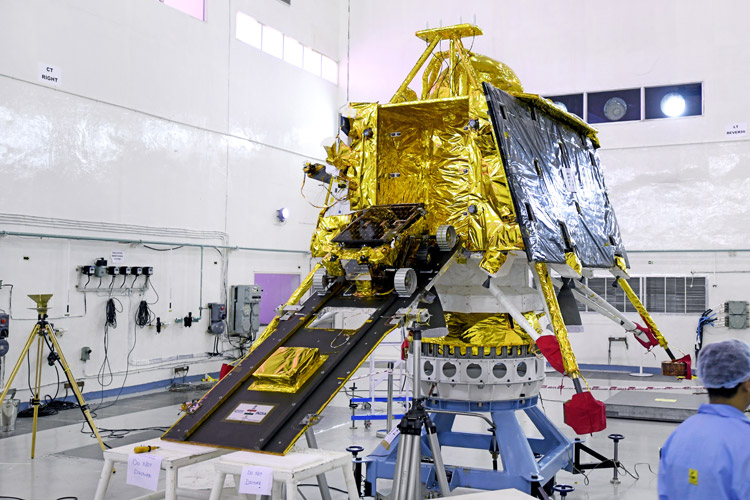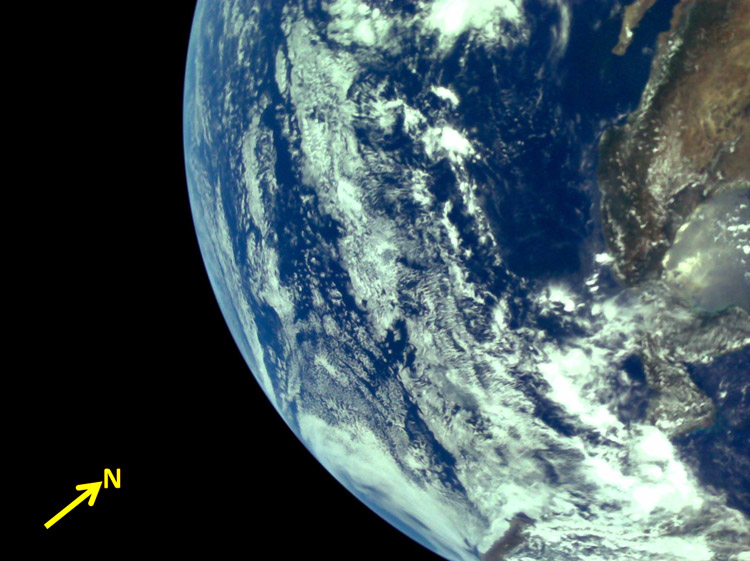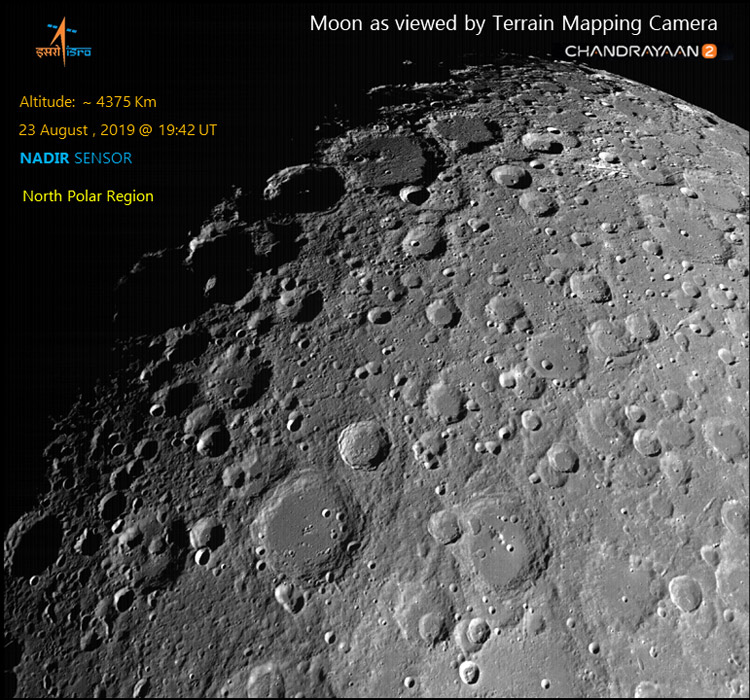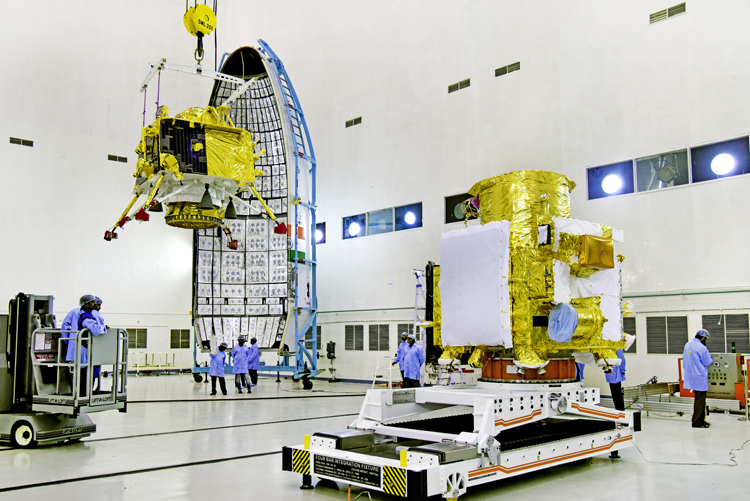INDIAN ARMED FORCES CHIEFS ON
OUR RELENTLESS AND FOCUSED PUBLISHING EFFORTS

SP Guide Publications puts forth a well compiled articulation of issues, pursuits and accomplishments of the Indian Army, over the years

I am confident that SP Guide Publications would continue to inform, inspire and influence.

My compliments to SP Guide Publications for informative and credible reportage on contemporary aerospace issues over the past six decades.
Lunar night casts shadow on possible re-communications with Vikram
Chandrayaan-2's Orbiter continues to satisfactorily perform science experiments while revolving around the moon even as the Lander and the Rover of the mission have been lost.
With the lunar day ending on the moon, any hope to reset the lost communications with the lander Vikram of Chandrayaan-2 mission is over. One lunar day i.e. one day on the moon is equal to 14 days on the earth. Hence ever since the communication was lost with Vikram on September 7, ISRO (Indian Space Research Organization) was making all efforts to re-establish contact. However, the possibility had the deadline of a lunar day as once the lunar night begins the chances of restarting communications are negligible owing to the extremely cold temperatures and the severe darkness of the lunar South Pole, the region where Vikram was scheduled to soft-land in the wee hours of September 7. The lander was designed to function for one lunar day and so was the rover, Pragyaan which was planned to roll out of Vikram after its soft landing and analyse the surface of the moon.

Having successfully performed all complex maneuvers and velocity variations, just a few minutes before it would have soft-landed and merely 2km above the lunar surface, the lander lost all communications with ISRO's mission control centre in Bengaluru.
The lander was designed to function for one lunar day and so was the rover, Pragyaan which was planned to roll out of Vikram after its soft landing and analyse the surface of the moon.
Launched on the three-stage GSLV-Mk-III-M1, Chandrayaan-2 carried an Orbiter, a Lander (named Vikram) and a Rover (named Pragyaan). The spacecraft hence consisted of these three individual modules that were held together as a single spacecraft named Chandrayaan-2 during the launch which took place on July 22, 2019.

While there have been no updates from the space agency, there were reports of Vikram having had a hard landing. ISRO just shared that they were making continuous efforts to analyse the cause of Vikram's lost communication.
#VikramLander has been located by the orbiter of #Chandrayaan2, but no communication with it yet.
— ISRO (@isro) September 10, 2019
All possible efforts are being made to establish communication with lander.#ISRO
On September 10, ISRO tweeted that the location of the Vikram was traced through a thermal image captured by Chandrayaan-2's Orbiter that continues to go around the moon, successfully carrying out the scientific contributions on its part.
"The Orbiter shall enrich our understanding of the moon's evolution and mapping of the minerals and water molecules in the Polar Regions, using its eight state-of-the-art scientific instruments," ISRO had earlier stated.
"Performance of all Orbiter payloads is satisfactory. The Orbiter continues to perform scheduled science experiments to complete satisfaction. National level committee consisting of academicians and ISRO experts are analysing the cause of communication loss with the lander," remarked ISRO.
The Orbiter carries eight payloads that will continue to conduct several significant scientific experiments during its life and add valuable information to the facts about the moon, thus aiding the future space explorations.

The agency also highlighted that the Orbiter camera is the highest-resolution camera (0.3m) in any lunar mission so far and shall provide high-resolution images which will be immensely useful to the global scientific community. Not only that the Orbiter which was planned for a life-span of one year earlier is now instead ensured of a long life as long as almost seven years owing to the precise launch and mission management.
On September 19, ISRO updated further about the Orbiter stating that all its payloads are powered and the initial trials for Orbiter payloads were successfully completed. "Performance of all Orbiter payloads is satisfactory. The Orbiter continues to perform scheduled science experiments to complete satisfaction. National level committee consisting of academicians and ISRO experts are analysing the cause of communication loss with the lander," remarked ISRO. After this, no official information has been delivered from ISRO's end.
With this release, the indications were a bit clear that the possibilities of restarting communications with Vikram are hardly any. Prior to this, the agency also expressed gratitude to everyone for standing by it. After Vikram lost communications on September 7, appreciation, encouragement, support and congratulatory greetings for its efforts flooded for ISRO from across the globe.
Thank you for standing by us. We will continue to keep going forward — propelled by the hopes and dreams of Indians across the world! pic.twitter.com/vPgEWcwvIa
— ISRO (@isro) September 17, 2019
There were also reports of NASA helping ISRO in figuring out Vikram's location and re-establish contacts. It was also said that NASA's Lunar Reconnaissance Orbiter was attempting to picture Vikram. However, no official information was released about the same.
On September 21, while on his way to attend a ceremony at IIT-Bhubaneswar, ISRO Chief Dr. K. Sivan reportedly stated the Chandrayaan-2 mission to have achieved 98% success. "Why we are saying Chandrayaan-2 achieved 98% success is because of two objectives -- one is science and the other technology demonstration. In case of technology demonstration, the success percentage was almost full. The Orbiter is also doing well and performing scheduled experiments," he was quoted.

Even while the hopes of a 100% success are lost with Chandrayaan-2, it has not dampened the spirits of the national space agency which gearing up for another moon mission in the coming year along with its mission to send men in space and many more missions.





